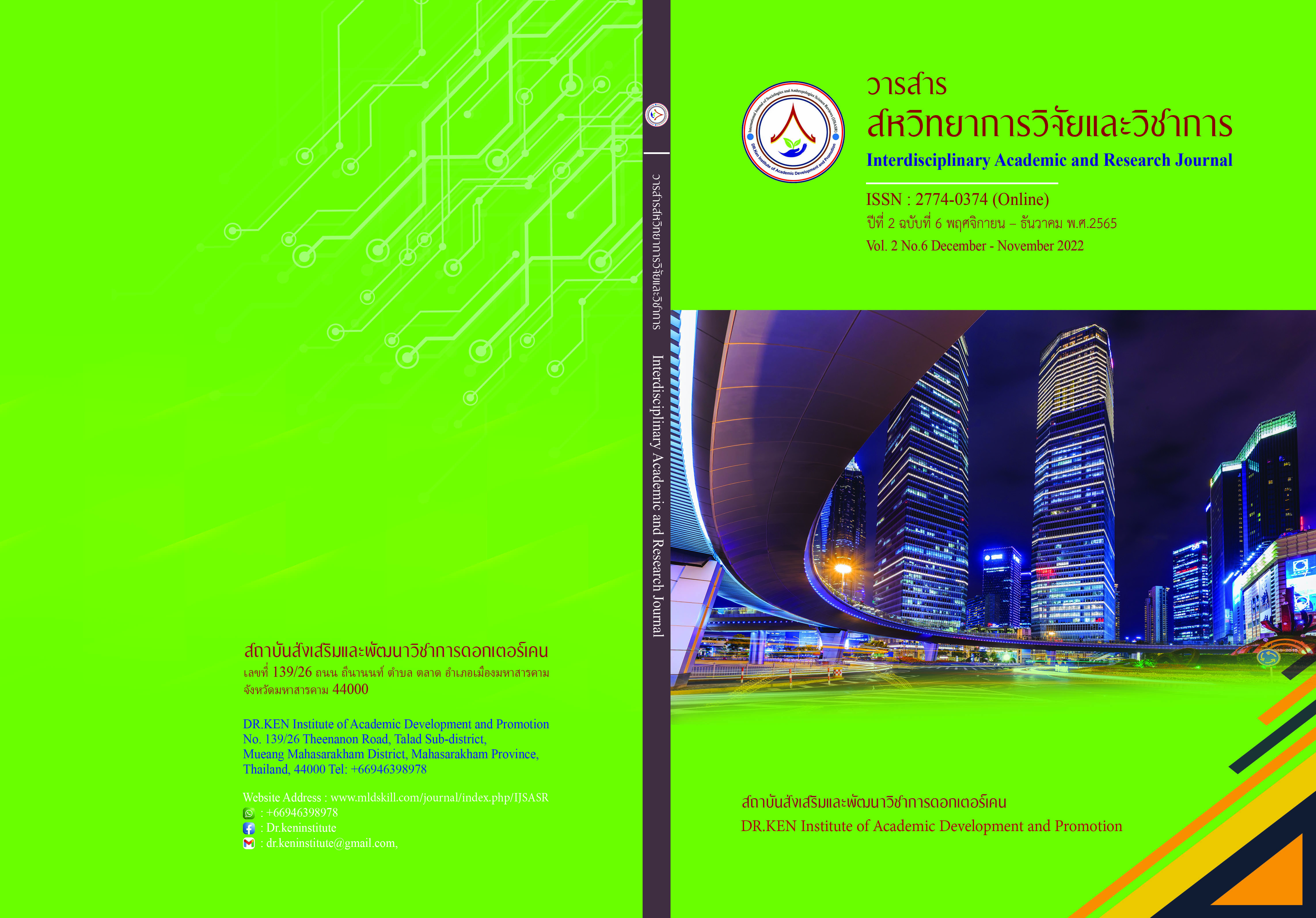Strategic Leadership Model based on The Four Paths of Accomplishment Culminating in Administrative Effectiveness of Schools under Khon Kaen Primary Educational Service Area Office 2
DOI:
https://doi.org/10.14456/iarj.2022.172Keywords:
Model; , Strategic Leadership; , Four Paths of Accomplishment; , Administrative EffectivenessAbstract
Organizational leaders, being the key engine that drives the organization, need specific characteristics, competencies or skills to lead the organization to compete with the changes that are taking place. School administrators therefore need to adjust new characteristics to suit the changing context, which good school administration should adopt the Four Paths of Accomplishment. to be applied to the administration of basic educational institutions as a guideline for successful administration. Therefore, this research aimed (1) to study the factors and indicators of strategic leadership model based on the Four Paths of Accomplishment in administrative effectiveness. (2) to examine the consistency and suitability of strategic leadership model based on The Four Paths of Accomplishment with empirical data. (3) to create the model of strategic leadership model based on The Four Paths of Accomplishment in administrative effectiveness. And (4) to assess the model of strategic leadership model based on The Four Paths of Accomplishment in administrative effectiveness of Schools under Khon Kaen Primary Educational Service Area Office 2. This research is mixed-method research. The sample group used in the research was educational institute administrators. and teachers in educational institutions Under the Office of Khon Kaen Primary Educational Service Area 2, 411 people interviewed 5 experts and 10 experts. The research instruments were questionnaires, and an assessment form for the use of factors and indicators, strategic leadership model based on The Four Paths of Accomplishment in administrative effectiveness. The statistics used to analyze the data are percentage, mean, standard deviation, confirmatory factor analysis, and Structural Equation Modeling. The results of research were found that: (1) the factors and indicators of strategic leadership model based on The Four Paths of Accomplishment in administrative effectiveness comprised 4 factors and 111 indicators. (2) The test of consistency of the model displayed χ2=9.462, df = 7, χ2/df =1.352, P-Value =0.728, CFI =0.987, TLI =0.982, RMSEA =0.005, SRMR =0.002, and the structural validity and reliability existed R2 at 0.754 - 0.884 exceeding 0.60, that featured the consistency with the empirical data. (3) Strategic leadership model using the Four Paths of Accomplishment that affects the effectiveness of school administration consists of 4 components. And (4) The evaluation results of the strategic leadership model using the Four Paths of Accomplishment that affect the effectiveness of school administration were found to be appropriate at a high level and could be used.
References
กิตติกาญจน์ ปฏิพนธ์. (2555). โมเดลสมการโครงสร้างภาวะผู้นำเชิงสร้างสรรค์ของผู้บริหารสถานศึกษาอาชีวศึกษา. วิทยานิพนธ์ปรัชญาดุษฎีบัณฑิต, สาขาวิชาการบริหารการศึกษา: มหาวิทยาลัยขอนแก่น.
จิราภรณ์ ผันสว่าง. (2562). ผู้นำกับการเป็นนักบริหารการศึกษามืออาชีพ Professional Education Leadership. มหาสารคาม: โรงพิมพ์มหาวิทยาลัยราชภัฏมหาสารคาม.
ชณัฐ พรหมศรี, สุจิตรา จรจิตร และ วัน เดชพิชัย. (2561). การพัฒนาองค์ประกอบและตัวบ่งชี้ภาวะผู้นำเชิงกลยุทธ์ของบริหารโรงเรียนประถมศึกษา ในสามจังหวัดชายแดนภาคใต้. วารสารเครือข่ายวิทยาลัยพยาบาลและการสาธารณสุขภาคใต้. 5 (2), 201-215.
ตวงพร รุ่งเรืองศรี. (2561). คุณลักษณะอันพึงประสงค์ของผู้บริหารในศตวรรษที่ 21. วารสารด้านการบริหารรัฐกิจและการเมือง. 7(1), 106-149.
ธีระเกียรติ เจริญเศรษฐศิลป์. (2559). การศึกษาไทย 4.0 ในบริบทการจัดการศึกษา. เพื่อการพัฒนายั่งยืน. กรุงเทพฯ: ศูนย์ประชุมวายุภักษ์
พระมหาวุฒิชัย วชิรเมธี (ว.วชิรเมธี). (2550). คนสําราญงานสําเร็จ. พิมพ์ครั้งที่ 3, กรุงเทพฯ: อมรินทร์พริ้นติ้งแอนด์พลับลิชชิ่ง จํากัด (มหาชน).
พระสมุห์พงศธร ปภงฺกโร, พระครูจิรธรรมธัช และ สมเดช นามเกตุ. (2564). การประยุกต์ใช้หลักอิทธิบาท 4 การบริหารงานของเทศบาลกุดจับ อำเภอกุดจับ จังหวัดอุดรธานี. Journal of Modern Learning Development. 6 (4), 241-254.
พิเชฐ ศรีหล้า, ชัชพงศ์ เทียมทันวณิช, วรเชษฐ์ โทอื้น และณัฐพล จินดารัมย์. (2562). กลการประยุกต์ใช้หลักอิทธิบาท 4 เพื่อพัฒนาประสิทธิภาพการ ปฏิบัติงานของบุคลากรภาครัฐสังกัดกระทรวงมหาดไทย จังหวัดยโสธร. Journal of Graduate MCU KhonKaen Campus. 6 (3), 665-686.
วิทวัส นิดสูงเนิน, สมบูรณ์ บูรศิริรักษ์ และมารุต พัฒผล. (2565). การพัฒนาโมเดลสมการโครงสร้างของปัจจัยที่ส่งผลต่อภาวะผู้นำเทคโนโลยี ของผู้บริหารสถานศึกษาในยุคดิจิทัล โรงเรียนมัธยมศึกษาในกลุ่มจังหวัด ภาคใต้ฝั่งอ่าวไทย สำนักงานคณะกรรมการการศึกษาขั้นพื้นฐาน. วารสารสหวิทยาการมนุษยศาสตร์และสังคมศาสตร์. 5 (4), 1638-1658.
Moonsarn, B., Phoncharoen, C., Jedaman, P., & Kenaphoom, S. (2022). Regional Educational Reform in Thailand: Needs Assessment and Personnel Management 4.0 for the 21st Century. International Journal of Sociologies and Anthropologies Science Reviews, 2(1), 31–42. https://doi.org/10.14456/jsasr.2022.4
Sricharumedhiyan, C., & Qingamo , P. S. (2022). Morality and Ethics for The Local Government Officiants. Interdisciplinary Academic and Research Journal, 2(3), 1–12. https://doi.org/10.14456/iarj.2022.22
Yu, Z., & Mhunpiew, N. (2022). A Model For Developing Student Leadership Skills in Normal Universities in Changsha, China. International Journal of Sociologies and Anthropologies Science Reviews, 2(4), 71–88. https://doi.org/10.14456/jsasr.2022.31
Zou, X., & Merritt, M. R. (2022). Transformational Leadership and Its’ Impact on Teacher’s Creative Behaviour in Chinese Universities. International Journal of Sociologies and Anthropologies Science Reviews, 2(6), 45–56. https://doi.org/10.14456/jsasr.2022.42
Downloads
Published
How to Cite
Issue
Section
License
Copyright (c) 2022 พระครูประโชติสารนิวิฐ ลมมนตรี, สุเทพ เมยไธสง, จิราภรณ์ ผันสว่าง

This work is licensed under a Creative Commons Attribution-NonCommercial-NoDerivatives 4.0 International License.
Copyright on any article in the Interdisciplinary Academic and Research Journal is retained by the author(s) under the under the Creative Commons Attribution-NonCommercial-NoDerivatives 4.0 International License. Permission to use text, content, images, etc. of publication. Any user to read, download, copy, distribute, print, search, or link to the full texts of articles, crawl them for indexing, pass them as data to software, or use them for any other lawful purpose. But do not use it for commercial use or with the intent to benefit any business.
















.png)


